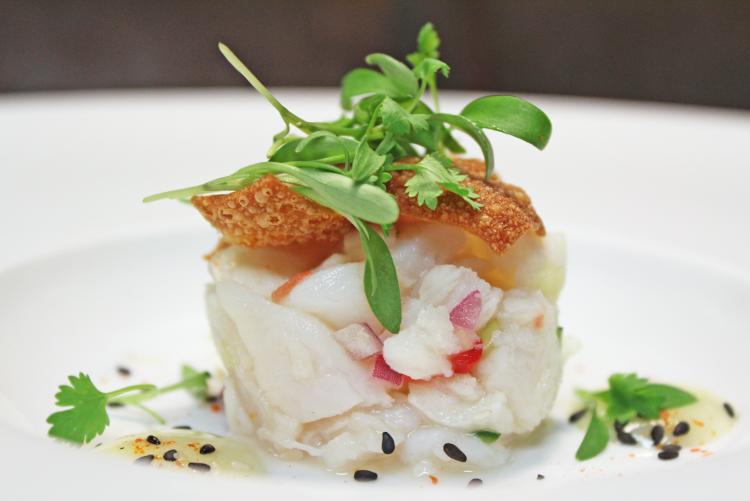
Description
This dish is a great representation of the collaborative environment that I try to foster at Stella. Pulling influences from different backgrounds, cultures, and styles is what we're constantly striving towards. This invariably leads to an awkward moment every time someone asks "So what kind of food do you do at Stella?" If we had to put our finger down and choose something concrete, then this halibut ceviche dish, a new favorite among guests and staff alike, probably would never have been conceived. Enter Stella's lead line cook Bree Vasquez. Like most of us, Bree's a mutt, but her mother is Mexican and that cultural heritage has greatly influenced her flavors and cooking style. Once I decided that I wanted to do a halibut ceviche, Bree called up her mom who generously agreed to share the family's recipe.
Ingredients
Instructions
With halibut being our top selling summer entree, I needed to figure out what I was going to do with all the trim that's generated when I break down the large sides into fillets. My golden rule at Stella is that everyone gets the same beautiful portion of fish; we never serve a tail piece or a thin belly section while charging the same price as the guest who received a beautiful, fat, center cut.
Start by cutting the halibut into half inch cubes. The smaller the cut on any fish that you're turning into ceviche, the faster it will "cook" in the acid. More on this in the notes section at the end of this recipe. Set the halibut aside in a small, non-reactive container (read plastic or glass, preferably plastic).

To start the ceviche: core, peel, and dice your tomatoes just like you would with a tomato concassé. If you're unfamiliar with this technique, start by removing the core of the roma tomato and then cut an X in the top of the Roma, extending it down to the core, making sure to only cut through skin, not the flesh. (See first two pictures below). Drop into boiling, salted water for about 30-60 seconds and then rapidly chill in an ice bath.
When removed from the ice bath, you'll notice that the skin on the tomato has started to peel back slightly. Gripping the skin between your knife blade and your thumb, peel it back, removing completely. From here, simply seed and dice.
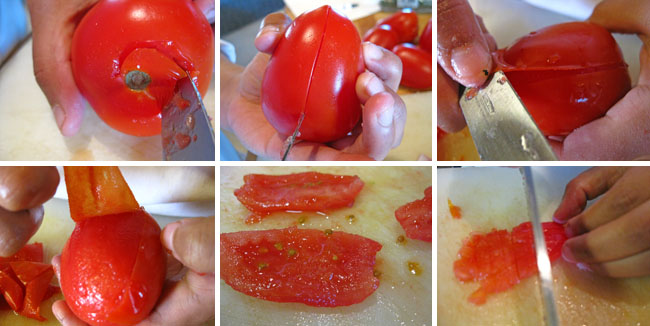
Next: peel, seed, and dice an English cucumber and add it to your tomatoes in an appropriately-sized mixing bowl. Add to this tomato/cucumber mixture the diced red onion, using the basic onion dicing technique.
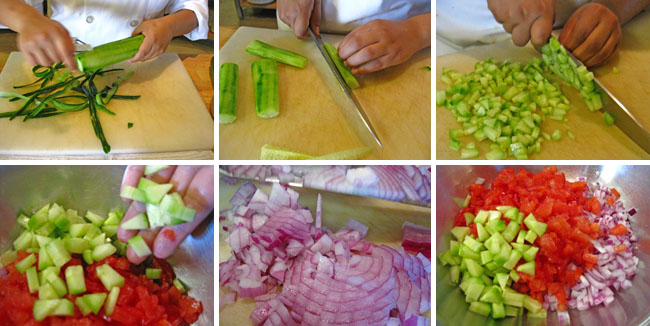
Add the diced cucumber, onion, and tomato to the halibut and mix thoroughly to achieve an even dispersion.

Cover your ceviche mixture with lime juice and add in the Clamato and ketchup. Yes, ketchup. Not because I say so, but because Bree's mom does. Ketchup is actually common in the ceviche recipes found in Northern Mexico, obviously influenced by their northern neighbor's infatuation with salsa el american.
The Clamato, a mix of clam juice and tomato juice, helps round out the flavors of the ceviche liquid as well. Add in some salt to taste, and a little sugar, to counterbalance the acidity of the lime juice and you're good to go.
Allow everything to marinade in the ceviche liquid for at least two hours before serving, but no longer then four. When the ceviche is ready to serve, you will notice that the flesh has turned opaque and has become firm, almost as if it were cooked (which technically speaking, it is).
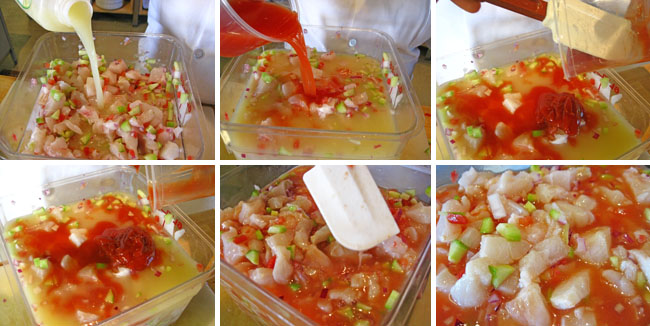
When serving the ceviche you can simply place it in a bowl and serve it alongside lime wedges, lightly chopped cilantro, and tortilla chips.
At Stella, we still needed a good "delivery system"; something that was scratch made, not just a deep fried tortilla chip.
Which leads me to our newest cook, Lupe Solis, who's smiling face you'll see only in the mornings if you're a guest at The Cedar House and come in for our private breakfast. Lupe has a killer chalupa recipe that he makes using rendered bacon fat. The chalupas puff up beautifully when fried, giving us a great "delivery system" for the ceviche itself. (The chalupa shells will be made available in an upcoming recipe post).
Instead of serving the ceviche "family style," we make a more composed plate, presenting the dish as an individual appetizer. When an order is received, we start by frying our home made chalupa shells in 375°F oil, flipping halfway through the frying process. While they fry, the chalupa will puff up slightly, creating a hollow center. After about 3 minutes, the fried chaulpa shells are quickly drained on paper towels and then moved to the plate.

Three chalupa shells are placed on a long "skateboard" and a spoon is used to break the top of the shell open, exposing a hollow center which holds the ceviche nicely. Then a little squirt of our "Hell Fire Aioli" is applied to each shell. This spicy, habenero-based aioli is an important part of the dish; sweet, tangy, and lightly spicy up front, with a lingering burn after each bite of ceviche is swallowed. It acts as both a palette cleanser and gives you nice little endorphin rush.
Next, we simply top each shell with a 1.5-2 ounce spoonful of ceviche, with any excess liquid squeezed off so it won't immediately "sog out" the chalupa shell before the guest has a chance to experience it's freshly fried, crisp texture in contrast to the tender chew of the halibut.
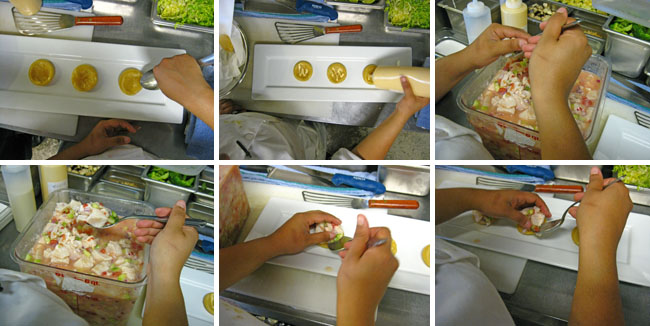
Garnish with lime wedges and fresh cilantro and enjoy with an ice cold beer, margarita or off dry Riesling.

There are 4 Comments
Like My Mom-in-Law's Recipe
Ecuadoran ceviche is also famous (or infamous to some) for using catsup as a component. This recipe shares many of the same ingredients as my wife's mother's recipe, who is Ecuadoran. I really like the addition of the habenero aioli - great idea. Last time my mother-in-law was visiting she made ceviche using shrimp, but she uses fish too - probably determined by whatever looks freshest when she's shopping.
BTW, I sometimes deep fry pita in this way, which also creates this puffed, hollow affect. I can take the pita and put it in a large toaster I have and it will create a similar affect. For some reason, the only Pita that works best for this is baked at a local Palestinian bakery, whose pita is much different in color, texture and flavor than any pita I've had.

I love good pita bread. Never
I love good pita bread. Never thought to put ceviche on it though. But then again, if you fry it up, it's almost like a cross between a chalupa and a tostada.
I never put ceviche on pita either....
I just use the same deep frying technique with pita and get a similar puffed, hollow result. I actually put honey on it after frying.
I'm surprised Bree (sp?) uses catsup in her ceviche. I've never heard of a Mexican doing that, only Ecuadorians.

Her mother is from Northern
Her mother is from Northern Mexico so you'll often see American ingredients like ketchup incorporated into certain items.
